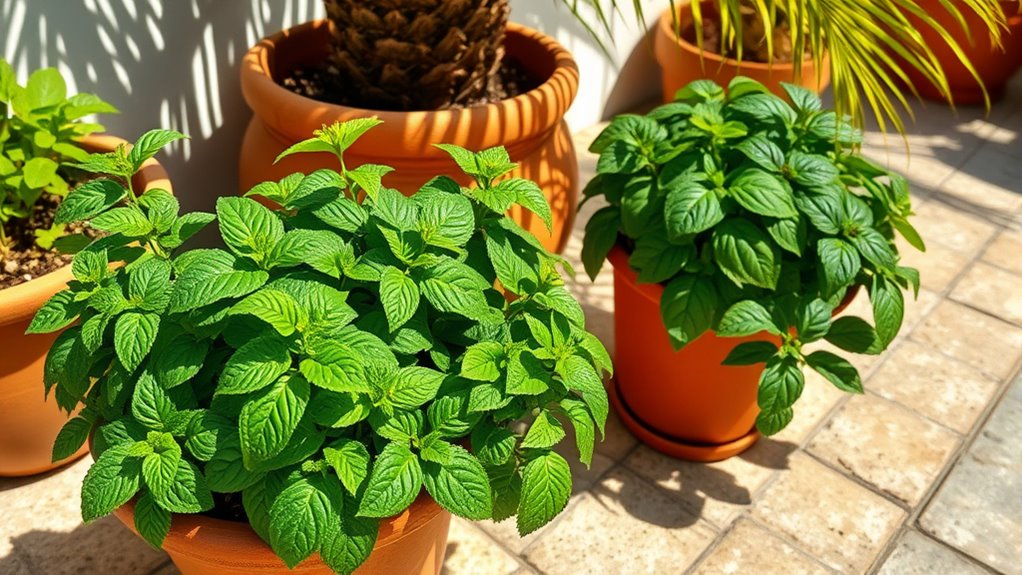At your beach home, you can grow shade-tolerant, edible herbs like mint and basil with proper protection from salty spray and wind. Plant them in raised beds or containers with well-draining soil, and place them where they get some shade during the hottest part of the day. Surrounding your herbs with windbreaks and using mulch will help them thrive despite coastal conditions. Keep exploring to discover tips for maximizing your garden’s success even in salty seaside environments.
Key Takeaways
- Mint thrives in shaded, humid coastal areas with well-draining soil and protection from salt spray.
- Basil benefits from partial shade during hot days to prevent wilting and bolting.
- Use raised beds or containers with organic compost to improve soil nutrients and drainage.
- Protect herbs with windbreaks like shrubs to shield from salty winds and enhance resilience.
- Mulch and proper watering help herbs retain moisture and stay healthy in beachside conditions.

Growing edible herbs at your beach home can be both rewarding and practical, even with the salty air and sandy soil. To make the most of your space, you should think carefully about herb garden design. Creating a designated area for your herbs helps protect them from harsh coastal conditions and keeps your garden organized. Consider raised beds or containers, which can improve drainage and prevent soil erosion caused by wind and waves. Position your herbs where they’ll receive some shade during the hottest parts of the day to shield them from intense sun and salt spray. This not only prolongs their lifespan but also enhances their flavor, making your herbs more enjoyable to use in your cooking.
Designing your herb garden with raised beds or containers protects plants from coastal salt and wind.
When planning your coastal planting tips, focus on selecting herbs that thrive in shaded, humid environments. Mint and basil are excellent choices because they love moist, protected spots. Mint, in particular, is hardy and can tolerate some salt, making it a great addition to your beach herb garden. Basil, on the other hand, prefers some shade during the heat of summer, which helps prevent it from wilting or bolting in the sun. Plant these herbs in containers or raised beds with well-draining soil, mixing in some organic compost to boost nutrients. Keep in mind that sandy soil often lacks nutrients, so regular feeding will give your herbs the boost they need to flourish.
Salty air can be tough on many plants, but mint and basil are relatively resilient when protected properly. To enhance their resilience, surround your garden with windbreaks like tall grasses or shrubs that help reduce salt spray and wind damage. Water your herbs regularly but avoid overwatering, since sandy soil drains quickly and can cause roots to dry out. Mulching around your plants helps retain moisture and keeps the roots cool, especially during hot summer days. Position your herbs thoughtfully, considering the prevailing wind direction, and you’ll create a microclimate that’s more hospitable for these resilient herbs. Additionally, selecting coastal-tolerant plants can further improve your garden’s success in salty environments.
Incorporating herbs like mint and basil into your coastal landscape not only provides fresh ingredients but also adds beauty and fragrance to your beach retreat. With some smart herb garden design and coastal planting tips, you can enjoy a thriving herb garden that withstands the salty air and sandy soil. These herbs will reward your efforts with abundant foliage and fresh flavors, making your beach home even more inviting and self-sufficient.
Frequently Asked Questions
How Often Should I Water Herbs at the Beach?
You should water your herbs at the beach about every 2-3 days, adjusting based on the drought tolerance of your plants and weather conditions. During hot, dry spells, increase watering frequency, but avoid overwatering, which can cause root rot. Keep the soil moist but not soggy. Regularly check moisture levels, especially in shaded areas, to guarantee your herbs stay healthy and vibrant without overdoing it.
Can I Grow Herbs in Containers on the Beach?
Yes, you can grow herbs in containers on the beach. Some beach herb varieties like mint and basil thrive with proper care. Don’t worry about the sandy soil; use quality potting mix and guarantee your containers have drainage. Follow container gardening tips, such as placing pots in partial shade and watering regularly, to keep your herbs healthy and thriving despite the beach environment.
What Pests Typically Attack Beach-Grown Herbs?
You’ll likely encounter pests like aphids, spider mites, and whiteflies attacking your beach-grown herbs. To manage them, use pest management strategies like encouraging natural predators or applying natural repellents such as neem oil or insecticidal soap. Regularly inspect your herbs and act early to prevent infestations. Keeping your herbs healthy and well-maintained helps reduce pest problems, so stay vigilant and treat pests promptly for thriving, pest-free herbs.
Are There Specific Soil Types Best for Beach Herbs?
You should choose soil with good drainage and soil compatibility for beach herbs. Look for sandy or loamy soil that meets their nutrient requirements, ensuring they don’t become waterlogged. Enrich the soil with organic matter like compost to boost nutrients and support healthy growth. Avoid heavy clay soil, which can hinder root development. Regularly amend your soil based on your herbs’ specific needs to keep them thriving at your beach home.
How Do I Protect Herbs From Salty Sea Air?
To protect your herbs from salty sea air, guarantee they have good salt tolerance by choosing hardy varieties. You should also provide wind protection with barriers like fences or shrub screens, which help reduce salt spray and wind damage. Regularly watering your herbs helps wash away salt buildup, and mulching helps retain moisture and shield roots. With these steps, your herbs will thrive despite the coastal conditions.
Conclusion
Just like the timeless wisdom of the seas, these herbs—mint and basil—bring freshness and flavor to your beachside haven. With a little care, you can turn your home into your own secret garden, echoing the bounty of Poseidon’s domain. So go ahead, nurture these natural shades, and let their vibrant aromas transport you to a coastal paradise every time you step outside. Your beach home is waiting for its own touch of green magic.










